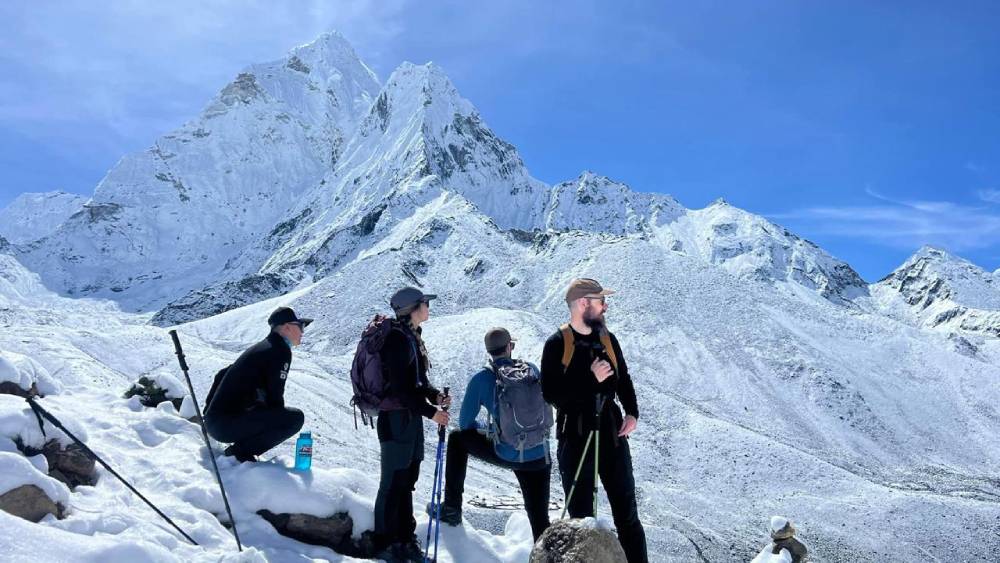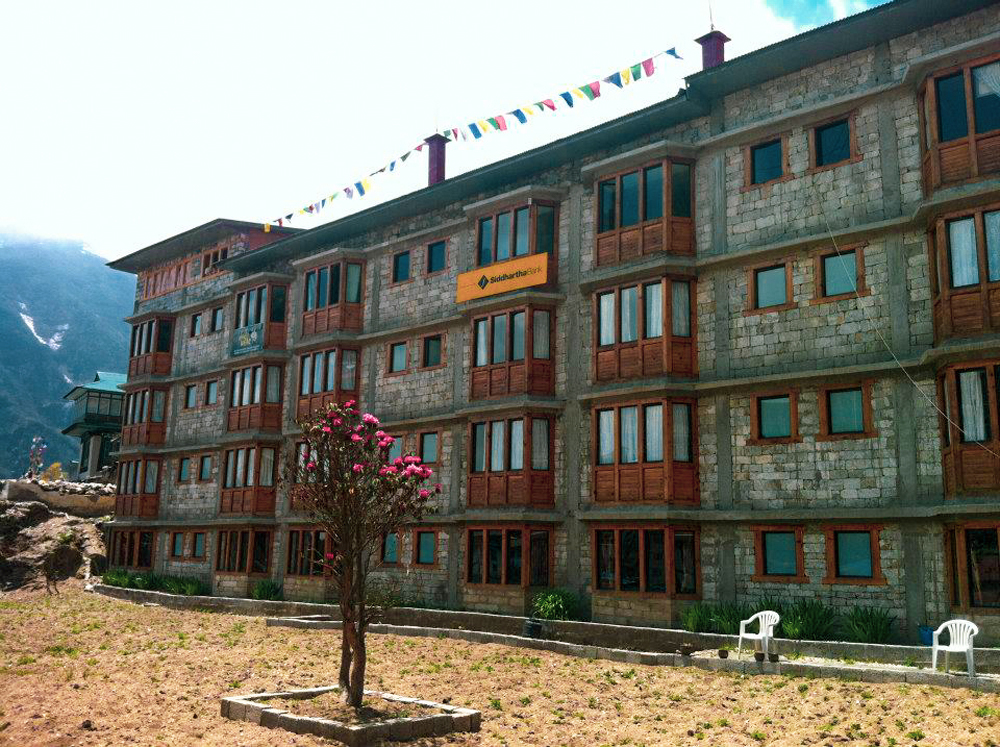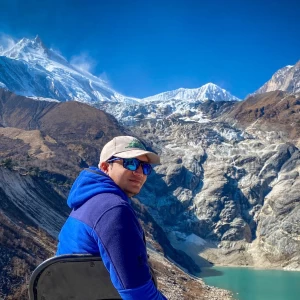If you are fit and exercise on a daily basis the Everest Base Camp Trek will be easy to moderate depending on how long and how much exercise per day. But if you are not really a fit one, a long hiker or you are not very active with exercise then the trek is definitely going to be a hard one.
How Difficult Is Everest Base Camp Trek?
Table of Contents
The Everest Base Camp trek is a moderate to strenuous adventure. It offers views of the Himalayan Mountains like Mount Everest (8,848.86 m/29,031.7 ft), Lhotse (8,516 m/27,940 ft), and many other Eastern Peaks of Nepal.
Trekkers pass through places like Namche Bazaar (3,440 m/11,286 ft) and Tengboche (3,867 m/12,687 ft). The trail involves steep ascents and rugged paths. Long walking hours make it physically demanding. Trekkers must prepare for high altitudes that can cause breathing difficulties and acute mountain sickness. Proper training and fitness are essential to complete the trek.
Base camp difficulty increases with altitude gain. Kala Patthar (5,545 m/18,192 ft) offers breathtaking views but requires effort to reach. Trekkers walk 5-7 hours daily, covering uneven terrain. Thin air above 5,000 meters (16,404 ft) adds to the challenge. Sudden weather changes, especially in winter, make the trek harder.
Acclimatisation stops at places like Dingboche (4,410 m/14,469 ft) to help reduce altitude sickness. Carrying proper gear and pacing yourself improves the chances of success.

Trekking Terrain and Physical Difficulty Level of Everest Base Camp Trekking
The Everest Base Camp trek is both challenging and rewarding. It tests your physical strength and endurance. Trekkers must prepare for steep ascents, rough trails, and long walking days. The trek requires determination and fitness, especially as the altitude increases.
Understanding the terrain and difficulty is key to planning this adventure. Proper preparation helps trekkers overcome challenges and enjoy this once-in-a-lifetime journey.
Steep Hills and Ascents
Most of the trek involves uphill climbing. From Namche Bazaar (3,440 m/11,286 ft) to Tengboche (3,867 m/12,687 ft), steep ascents challenge your legs and stamina. The paths require a steady, moderate pace to avoid exhaustion.
Higher altitudes make climbs tougher as the air gets thinner. Regular breaks help your body adjust. Reaching places like Tengboche rewards you with incredible views of Mount Everest and other peaks.
Rough Terrain
The trekking terrain is rugged and uneven. You’ll hike on rocky paths, cross narrow suspension bridges, and navigate high trails. Some sections are slippery or steep, requiring focus and good trekking shoes.
Trails near Dingboche (4,410 m/14,469 ft) and Gorak Shep (5,164 m/16,942 ft) are especially challenging. The uneven terrain tests your balance and endurance. Despite the difficulty, these trails lead to stunning views and unforgettable experiences.
Long Days of Walking
Trekkers walk for 6-8 hours daily, covering 12-15 kilometres. Days often begin early to maximise daylight. Steep inclines and long distances make the trek physically demanding. Rest stops in villages like Phakding (2,610 m/8,562 ft) and Lobuche (4,940 m/16,207 ft).
They offer a chance to recover your stamina and energy. Each day’s effort brings you closer to the base camp. Staying hydrated and maintaining a steady pace helps manage fatigue and ensures a safer journey.
Altitude Challenges and Acute Mountain Sickness (AMS) During EBC Trek
The Everest Base Camp trek brings the thrill of reaching high altitudes. However, it also presents altitude-related challenges. As you climb higher, the air becomes thinner, making breathing difficult. Trekkers must be aware of Acute Mountain Sickness (AMS) and its risks. Proper Everest Base Camp Trek preparation and acclimatization can help prevent altitude-related issues. Understanding these Everest Trek challenges ensures a safer and more enjoyable trek.

Gaining Altitude
A gradual ascent is key to avoiding altitude sickness. The trek follows the "climb high, sleep low" method. For example, you trek from Namche Bazaar (3,440 m/11,286 ft) to Tengboche (3,867 m/12,687 ft) and sleep at a lower altitude in Debuche generally almost at the altitude of 3,600 metres. The altitude difference from Dingboche (4,410 m/14,469 ft) to Lobuche (4,940 m/16,207 ft) is significant, requiring extra caution. Taking it slow allows your body to adjust and reduces the risk of AMS.
Altitude Sickness
Altitude sickness often starts above 3,000 meters (9,842 feet). Common symptoms include headaches, nausea, and fatigue. Acclimatization days, like those in Namche Bazaar or Dingboche, help your body adjust to the thin air. Staying hydrated and avoiding alcohol are also important. Listening to your body and taking necessary precautions can prevent serious complications.
Highest Altitudes of Everest Base Camp Trek
Everest Base Camp sits at 5,364 meters (17,598 feet). The optional hike to Kala Patthar reaches 5,643 meters (18,514 feet). At these heights, oxygen levels are much lower, making breathing harder. Trekking here requires proper acclimatization and preparation. Reaching these points is a major achievement, but safety must always come first.
Serious Risk of Acute Mountain Sickness
Higher altitudes increase the risk of AMS. Trekking too quickly can lead to serious symptoms. Slow and steady pacing is essential. Trekkers should monitor themselves for dizziness, nausea, or severe headaches. If symptoms worsen, descending to a lower altitude is crucial. Ignoring AMS can lead to life-threatening conditions like High Altitude Pulmonary Edema (HAPE).
Note: Contact your guide immediately, if any of the members of the trekking team have any kind of symptoms.
Physical Fitness and Preparation for a Successful EBC Trekking
The Everest Base Camp trek is physically demanding, but proper preparation can make it achievable for many. The trek involves long hours of walking, steep ascents, and high-altitude challenges.
Understanding how difficult is the Everest Base Camp trek and training accordingly can greatly improve your experience. Below are specific suggestions to help you prepare effectively for this incredible journey.
Fitness Level
A good fitness level is crucial for tackling the steep trails and high altitudes of the trek.
Strengthen your legs for ascents like the Namche Bazaar climb (3,440 m/11,286 ft).
Build stamina to handle daily treks of 12–15 km from Tengboche (3,867 m/12,687 ft) to Dingboche (4,410 m/14,469 ft).
Practice stair climbing to prepare for steep sections, such as Lobuche (4,940 m/16,207 ft).
Train with a weighted backpack to simulate carrying gear on rugged paths.
Training for the Trek
Preparing your body for high-altitude trekking takes time and consistent effort.
Hike on trails similar to those between Lukla (2,860 m/9,383 ft) and Phakding (2,610 m/8,562 ft).
Gradually increase your hike duration to match daily walks of 6–8 hours.
Practice carrying a 5–7 kg backpack on rocky terrain to prepare for rough trails.
Train on steep inclines like those leading to Kala Patthar (5,643 m/18,514 ft).
Recommended Pacing
Maintaining a steady pace is essential for managing physical exertion and preventing exhaustion.
Walk slowly, especially on steep ascents like the Tengboche climb (3,867 m/12,687 ft).
Rest frequently at key stops like Dingboche (4,410 m/14,469 ft) to adjust to the altitude.
Hydrate often and avoid rushing during longer treks, such as Gorakshep to EBC (5,364 m/17,598 ft).
Monitor your breathing and energy levels during high-altitude sections.

First-Time Trekkers
First-time trekkers can succeed with proper preparation and guidance.
Hire a guide or join a group for safety on trails.
Train for at least 3–4 months to handle the challenges of reaching Everest Base Camp (5,364 m/17,598 ft).
Acclimatise at stops like Namche Bazaar (3,440 m/11,286 ft) and Dingboche (4,410 m | 14,470 ft) to prevent altitude sickness.
Pack light but include essentials like trekking poles and proper footwear.
Acclimatisation During an Everest Trekking
Acclimatisation is vital for a safe and enjoyable Everest Base Camp trek. It helps the body adjust to high altitudes, reducing the risk of Acute Mountain Sickness (AMS).
Knowing how difficult is Everest Base Camp trek makes acclimatization a critical part of your journey. Trekkers spend rest days in key locations to allow gradual adaptation to the thinning air and lower oxygen levels.
Importance of Acclimatization
Acclimatisation ensures your body adjusts to reduced oxygen at high altitudes. Without it, AMS symptoms can become severe. Rest days at Namche Bazaar (3,440 m/11,286 ft) and Dingboche (4,410 m/14,470 ft) are essential. These stops let you prepare for higher elevations like Gorakshep (5,164 m/16,864 ft) and Everest Base Camp (5,364 m/17,598 ft). Skipping acclimatization increases risks and makes the trek harder.
Sleep Low, Climb High
This method helps improve acclimatisation by balancing altitude gain and rest. Climb to a higher elevation during the day and descend to sleep at a lower altitude.
Hike to Everest View Hotel (3,880 m/12,729 ft) from Namche Bazaar for practice.
Ascend Nangkartshang Peak(Nagarjuna Hills) (5,083 m/16,676 ft) during a rest day in Dingboche.
Avoid overexertion while descending to maintain energy for the next day.
Mental Challenges for Everest Base Camp Trek
The Everest Base Camp trek is as mentally challenging as it is physically demanding. Trekkers face extreme conditions, unpredictable weather, and high altitudes. Mental preparation is crucial for overcoming the journey’s hardships. Knowing these challenges helps you build resilience for the trek.
Mental Toughness
Trekking at high altitudes can be mentally exhausting. Dingboche is at 4,410 meters (14,469 feet). Patience is essential to handle fatigue. Perseverance helps manage discomfort.
Mood swings are common above 4,000 meters. Trekkers should stay respectful to locals, guides, and porters, even during tough times.
Risk of Injuries
The rugged terrain poses a risk of sprains, slips, and falls. Areas like the trail from Lobuche (4,940 m/16,207 ft) to Gorakshep (5,164 m/16,942 ft) are particularly challenging. Always inform your guide immediately if you sustain an injury. They can provide assistance or arrange help if necessary.
Dealing with Difficult Conditions
Trekkers must endure extreme cold, long walking days and sudden weather changes. Temperatures can drop significantly at higher elevations, such as at Everest Base Camp (5,364 m/17,598 ft). Dressing in layers and staying mentally prepared for harsh conditions is essential for success.
Weather Conditions and Seasonal Considerations
Everest Base Camp weather varies greatly by season. Trekkers should plan according to their preferences and safety. Understanding each season's conditions helps prepare them for the challenges and rewards of the trek.

Monsoon and Winter Seasons
The monsoon season (June-August) brings heavy rain and slippery trails. Trails like those near Lukla (2,860 m | 9,383 ft) and Namche Bazaar (3,440 m | 11,286 ft) become muddy and challenging.
Winter (January-February) is extremely cold, with snow blocking some high-altitude routes, like Gorak Shep (5,164 m | 16,942 ft).
Food options at higher altitudes like Gorak Shep and Lobuche (4,940 m | 16,210 ft) are limited. Common food includes:
Instant noodles
Dal Bhat (rice and lentils)
Basic soup
Tea or coffee
Best Trekking Seasons
The pre-monsoon season (March-May) is ideal for trekking. The skies are clear. Wildflowers bloom along the trails. The post-monsoon season (September-November) also offers stable weather. It provides the best mountain views. However, these months are busier. More trekkers fill the trails and guesthouses. This can make the experience less peaceful.
You won’t believe that the Khumbu region has almost every food delicacy. However, it is only available during the Peak seasons.
Technical Skills Required for Everest Base Camp Trekking
The Base Camp trek is physically demanding but does not require mountaineering skills. However, trekkers should have a good level of fitness and stamina. Preparation is key to successfully completing the trek.
It’s recommended to consult the Himalayan Scenery Treks team to ensure you're well-prepared for the trek.
Do You Need Mountaineering Skills?
No, you do not need technical mountaineering skills for the Everest Base Camp trek. The trek is suitable for those with basic trekking experience. However, it requires good physical fitness and preparation. Steep ascents and long trekking days demand stamina. You will need the following essential trekking equipment:
Sturdy Trekking Boots: Provide support and protect your feet during long treks.
Trekking Poles: Help with balance and reduce strain on your knees.
Sleeping Bag: Essential for warmth during cold nights at higher altitudes.
Warm Clothing: Keeps you warm in freezing temperatures, especially at night.
Water Bottle or Hydration System: Keeps you hydrated during long treks.
Headlamp or Flashlight: For visibility in the dark(For slow-paced walkers).
Sunscreen and Sunglasses: Protects against sun exposure, especially at high altitudes (Above 4000 meters).
Climbing Kala Patthar
Climbing Kala Patthar at 5,545 meters (18,192 feet) is not technically difficult, but it is challenging. The climb is steep and can be strenuous, especially at high altitudes. However, the views from the top are worth the effort.
You will see iconic peaks like Mount Everest (8,848 meters | 29,029 feet), Lhotse (8,516 meters | 27,939 feet), and Makalu (8,485 meters | 27,838 feet). The summit offers one of the best panoramic views of the Khumbu region.
Trekking with Local Guides and Porters of Everest
Trekking in the Everest region can be challenging. Having local guides and porters with you can make the experience easier and more enjoyable. They are experts in the terrain and climate, offering valuable support throughout the journey.
This not only enhances safety but also contributes to the local economy. At Himalayan Scenery Treks, we support regenerative tourism, ensuring your trek benefits both you and the local communities.
Benefits of Guided Trekking
Guided trekking offers several advantages. Local guides help manage logistics, ensuring a smooth trek. They provide valuable advice on acclimatization to avoid altitude sickness. Guides also assist with navigating tough terrains, making the journey safer. Here are the key benefits:
Acclimatization Advice: Guides ensure you adjust to high altitudes properly.
Safety Guidance: Guides are trained to handle emergencies and ensure safety.
Local Knowledge: They offer cultural insights and knowledge about the area.
Route Navigation: Guides help you stay on the correct path and avoid hazards.
Hiring Porters
Porters are a valuable asset for trekkers. They help carry heavy loads, allowing trekkers to travel with lighter daypacks. This makes the trek more comfortable and manageable, especially for longer distances. Porters are skilled at handling difficult terrain and weather conditions. By hiring porters, you support the local economy and contribute to sustainable tourism in the Everest region.
Accommodation and Facilities Along the Route of EBC
Trekking to Everest Base Camp requires overnight stays at various accommodations along the way. These places range from basic tea houses to more luxurious lodges. The availability of these accommodations varies depending on the season and altitude. It's important to know what to expect at different stops during your trek to ensure a comfortable journey.

Tea Houses and Guest Houses
Along the Everest Base Camp route, tea houses and guest houses are the primary accommodations. These provide basic rooms and common areas to rest. Comfort can vary depending on the altitude.
At lower altitudes, like Namche Bazaar (3,440 meters / 11,286 feet), accommodations are more comfortable.
At higher altitudes, such as Gorak Shep (5,164 meters / 16,942 feet), facilities become more basic. However, the required facilities are always available.
Some luxury lodges are available at select locations like Namche Bazaar and Dingboche (4,410 meters / 14,470 feet).
Food and Drinks
Tea houses along the Everest Base Camp route offer simple meals to keep trekkers energized. Common food options include:
Dal Bhat (lentil soup with rice)
Noodles
Momos (dumplings)
Rice and vegetable curry
Potatoes (fried or boiled)
Soup (vegetable or noodle)
Eggs (boiled or fried)
Toast with jam or butter
Tea, coffee, and hot chocolate
Additionally, trekkers can enjoy food from other cuisines, including:
Pizza (especially in lower altitudes)
Spaghetti and pasta
Sandwiches
Fried rice
Instant noodles
Conclusion
The Everest Base Camp trek is physically challenging but manageable with proper preparation. The trek reaches high altitudes like Namche Bazaar at 3,440 meters (11,286 feet) and Everest Base Camp at 5,364 meters (17,598 feet).
To answer the question of how difficult is Everest Base Camp trek, you need the right information about Everest.
Acclimatisation is key at places like Namche and Dingboche, which sit at 4,410 meters (14,470 feet). Despite the difficulties, trekkers are rewarded with stunning views of Everest at 8,848 meters (29,029 feet) and Lhotse at 8,516 meters (27,940 feet).

